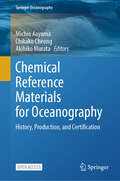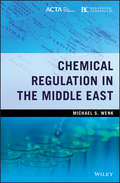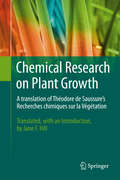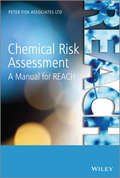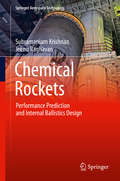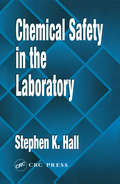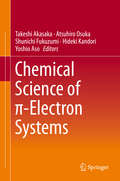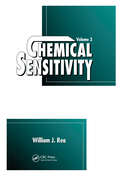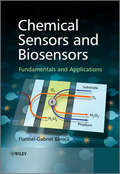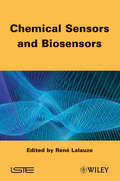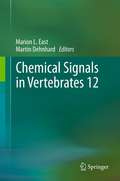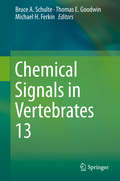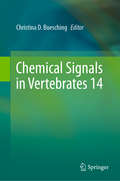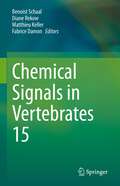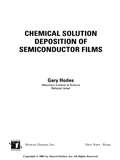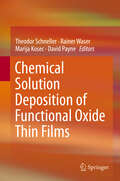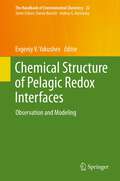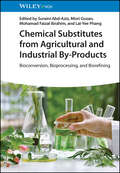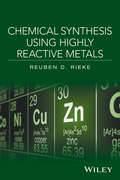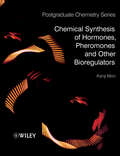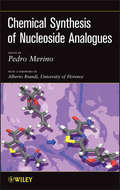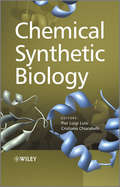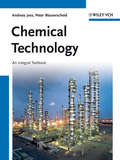- Table View
- List View
Chemical Reference Materials for Oceanography: History, Production, and Certification (Springer Oceanography)
by Michio Aoyama Chikako Cheong Akihiko MurataThis open access book explores the history, production, and certification of reference materials for essential parameters in oceanography and provides a comprehensive understanding of them to readers. Because inorganic macro-nutrients, salinity, dissolved oxygen, and carbonate system parameters, including dissolved inorganic carbon, total alkalinity, and pH, are essential parameters in oceanography, they can be used to define biogeographic provinces, monitor ocean health, and detect decadal-scale oceanic climate changes. Without reference materials for these parameters, it would be difficult to produce reliable data sets or long-term baseline studies that are required to verify global change and oceanic stability. The book includes chapters on developing new reference materials for density, dissolved oxygen, dissolved organic carbon, dissolved organic matter, and trace metals, which are also important in oceanographic studies. The lead authors of each chapter regarding these parameters are top scientists in these areas; hence, this is the most comprehensive book of chemical reference materials for ocean science, written by experts in each field. The book is a useful resource for readers to find the latest information and status of certified reference materials (CRM) and reference materials (RM) and of ways to use CRM in their studies. We are in the middle of the United Nations Decade of Ocean Science for Sustainable Development (2021–2030), to which this book makes a timely contribution.
Chemical Regulation in the Middle East
by Michael S. WenkA noted expert offers a guide to the complex chemical regulations in the Middle East region Chemical Regulation in the Middle East offers an essential guide to the patchwork of chemical regulatory programs and the complex system of permits and licenses that manage chemicals in the countries of the Middle East. The book explores the range of ministry, legislative, and other decrees that encompass pesticides, occupational safety and health, as well as safety data sheets and product labels that address regulation to widely-varying degrees. The author explores the Cooperation Council for the Arab States of the Gulf and reviews the key regulatory agencies and chemical substance regulations. The text outlines the pesticide regulations, occupational safety and health regulations, waste regulations and safety data sheets and labels in Bahrain, Egypt, Israel, Kuwait, Oman, Pakistan, Saudi Arabia, United Arab Emirates and Abu Dhabi. This important guide: Offers a compendium of the diverse range of chemical regulations in the countries of the Middle East Untangles the complex system of permits and licenses that are unique to the various countries in the Middle East Contains information based on the research and experience of a noted expert in the field Includes a review of the key regulatory agencies and chemical substance regulations of the Arab States of the Gulf Written for chemical organisations and professionals doing business in the Middle East, Chemical Regulation in the Middle East offers a must-have resource that details the unique chemical regulations in each country in the region.
Chemical Research on Plant Growth: A translation of Théodore de Saussure's Recherches chimiques sur la Végétation by Jane F. Hill
by Jane F. Hill Théodore De SaussureRecherches Chimiques sur la Végétation was a seminal work in the development of the understanding of photosythesis and plant chemistry. The original publication, which was the first concise summation of the basics of plant nutrition, was a landmark in plant science. It was twice translated into German during the nineteenth century, but no English translation has been published. This translation will interest those in the plant, chemical, agricultural, and soil sciences, and the history of science, who find English more accessible than French or German and who wish to learn more about the early research on photosynthesis and plant science. Nicholas-Théodore de Saussure, a Swiss plant physiologist and plant chemist, was the last of the early pioneers of photosynthesis research. This initial period of research is generally considered to have begun with Jan van Helmont in the early seventeenth century and Stephen Hales in the first part of the eighteenth, then to have become more intense with Joseph Priestley, Jan Ingen-Housz, and Jean Senebier during the Scientific Revolution of the mid-to-late eighteenth century. Nicholas-Théodore's father, the famous Swiss geologist, meteorologist, and Alpine explorer Horace-Bénédict de Saussure, had been an early convert to the new chemical theories pioneered by Antoine Lavoisier in the late eighteenth century. Nicholas-Théodore, younger than his predecessors, had the full advantage of this new approach, which stressed quantitative chemical methods. Applying these methods to plants, Nicholas-Théodore de Saussure performed experiments that led him to major insights into plant nutrition. His most important contributions were the demonstration that water is a component of plant dry matter; that plants obtain their carbon from the carbon dioxide of the air, not from carbonic acid dissolved in the soil water, as most of his contemporaries believed; and that mineral elements and nitrogen from the soil are essential to plant growth. Further, he demonstrated the central fact of plant respiration (the absorption of oxygen and emission of carbon dioxide); and photosynthesis (the decomposition of carbon dioxide and evolution of oxygen in the light). In Recherches Chimiques sur la Végétation, de Saussure synthesized his own research findings with those of his predecessors, producing a pioneering work on plant nutrition. In the two centuries since Recherches Chimiques sur la Végétation was published, luminaries in various branches of science, including plant biology, chemistry, and soil science, have consistently praised it highly. In the nineteenth century, noted botanist Alphonse de Candolle and equally noted plant physiologist Julius von Sachs expressed great admiration for it. Although de Saussure's ideas were forgotten for a time, famed chemist Justus von Liebig, who invented artificial fertilizer, rediscovered them in the 1840s and brought them to the attention of the agricultural community, stressing their importance for increasing crop yields. In the twentieth century, eminent photosynthesis researcher Eugene Rabinowitch described Recherches Chimiques sur la Végétation as the first modern book on plant nutrition. Historian of chemistry Henry Leicester called the book a classic, noting that the first important generalization about biochemistry in the nineteenth century came from it. Plant physiologist P. E. Pilet stated that the book laid the foundations of a new science, phytochemistry. Soil scientist E. Walter Russell attributed to de Saussure the quantitative experimental method, which more than anything else made modern agricultural chemistry possible. Chemist Leonard K. Nash stated that de Saussure brought the studies of plant nutrition begun by Priestley, Ingen-Housz, and Senebier close to completion, finishing the basic experimental work and providing a convincing theoretical interpretation of the field, and also opened up new vistas of experiment and thought. A further note about the translation: This project is more t...
Chemical Risk Assessment
by Peter FiskThis book is an essential guide and support to understanding of the science and policy, procedure and practice that underpins the REACH risk assessments required for the use and placing on the market of chemicals in the European Union. A clear understanding of information provision and how this affects the assessment of chemical safety is fundamentally important to the success of policy on chemicals and ultimately to the sustainability of the chemicals industry. Within the book, the scientific processes that underpin the policy are explained in a practical way. Importantly, it includes coverage of techniques to help solve the problems of using potentially risky and hazardous chemicals through the use of less hazardous alternatives and 'green chemistry', and also the analysis of the risks of the use of the most hazardous substances against the social and economic benefits of use. Chemical Risk Assessment: A Manual for REACH covers the following main themes: i) Assessment of chemical risk; ii) Risk management; iii) Hazard reduction, substitution and green chemistry; iv) Risk versus benefit - socio-economic analysis. The book acts as a practical guide and overview to chemicals risk assessment and risk management (in the EU context), as well as a support text for planning for the challenges of the future, which will see ever-increasing pressure to withdraw hazardous substances from the EU (and global) market, balanced against opportunities for innovation in the development of less hazardous chemicals.
Chemical Rockets: Performance Prediction and Internal Ballistics Design (Springer Aerospace Technology)
by Subramaniam Krishnan Jeenu RaghavanThe purpose of this book is to discuss, at the graduate level, the methods of performance prediction for chemical rocket propulsion. A pedagogical presentation of such methods has been unavailable thus far and this text, based upon lectures, fills this gap. The first part contains the energy-minimization to calculate the propellant-combustion composition and the subsequent computation of rocket performance. While incremental analysis is for high performance solid motors, equilibrium-pressure analysis is for low performance ones. Both are detailed in the book's second part for the prediction of ignition and tail-off transients, and equilibrium operation. Computer codes, adopting the incremental analysis along with erosive burning effect, are included. The material is encouraged to be used and presented at lectures. Senior undergraduate and graduate students in universities, as well as practicing engineers and scientists in rocket industries, form the readership.
Chemical Safety in the Laboratory
by Stephen K. HallNothing is more important to an organization than the health and safety of its workers. The managerial effectiveness of any health and safety program is judged on the basis of how well it prevents injuries and ill health. Chemical Safety in the Laboratory provides a proven approach to implementing and maintaining an effective chemical safety program for laboratories in hospital, industrial, and educational settings. Based on 20 years of experience managing and auditing chemical safety programs, the author discusses the OSHA Laboratory Standard and the Chemical Hygiene Plan, provides guidelines for the effective use of personal protective equipment, and details chemical emergency planning and response procedures. He also outlines a 19-step decontamination procedure for emergency responders. Employee chemical exposure monitoring and victim handling procedures are among the other major topics covered in this essential guide.
Chemical Science of π-Electron Systems
by Takeshi Akasaka Hideki Kandori Atsuhiro Osuka Shunichi Fukuzumi Yoshio AsoThis book presents the most advanced review available of all aspects of π-electron systems, including novel structures, new synthetic protocols, chemical and physical properties, spectroscopic and computational insights, molecular engineering, device properties and physiological properties. π-Electron systems are ubiquitous in nature. Plants convert light energy into chemical energy by photosynthetic processes, in which chlorophylls and other porphyrinoids play an important role. On the one hand, research to learn about photosynthesis from nature has led to understanding of electron and energy transfer processes and to achieving artificial energy conversion systems inspired by nature. On the other hand, recent advances in organic and inorganic chemistry make it possible to construct novel π-electron systems that had never existed in nature. The authors of this book are from a variety of research fields including organic chemistry, inorganic chemistry, physical chemistry, materials science, and biology, providing a comprehensive overview of π-electron systems for a broad readership. Not only specialists but also graduate students working in π-electron systems will find the book of great interest. Throughout, the diverse potential for future fruitful applications of π-electron systems is revealed to the reader.
Chemical Sensitivity, Volume I: Clinical Manifestation, Volume Iii
by William J. ReaChemical Sensitivity is the first major scientific book series on chemical sensitivity, an increasingly important worldwide health problem. This four-volume series features results from the study of more than 20,000 environmentally sensitive patients at the Environmental Health Center (EHC) in Dallas. Results from the study at EHC are supplemented by information accumulated from the treatment and study of an estimated 100,000 patients by other environmentally oriented physicians and scientists around the world.
Chemical Sensitivity: Clinical Manifestation, Volume III
by William J. ReaThe volumes that comprise Chemical Sensitivity are the first major scientific books to be published on chemical sensitivity, a growing world-wide health problem. These volumes present clinical experiences in diagnosing and treating chemical sensitivity in over 20,000 patients under controlled conditions.
Chemical Sensors and Biosensors
by Florinel-Gabriel BanicaKey features include:Self-assessment questions and exercisesChapters start with essential principles, then go on to address more advanced topics More than 1300 references to direct the reader to key literature and further readingHighly illustrated with 450 figures, including chemical structures and reactions, functioning principles, constructive details and response characteristicsChemical sensors are self-contained analytical devices that provide real-time information on chemical composition. A chemical sensor integrates two distinct functions: recognition and transduction. Such devices are widely used for a variety of applications, including clinical analysis, environment monitoring and monitoring of industrial processes. This text provides an up-to-date survey of chemical sensor science and technology, with a good balance between classical aspects and contemporary trends. Topics covered include: Structure and properties of recognition materials and reagents, including synthetic, biological and biomimetic materials, microorganisms and whole-cellsPhysicochemical basis of various transduction methods (electrical, thermal, electrochemical, optical, mechanical and acoustic wave-based)Auxiliary materials used e.g. synthetic and natural polymers, inorganic materials, semiconductors, carbon and metallic materialsproperties and applications of advanced materials (particularly nanomaterials) in the production of chemical sensors and biosensorsAdvanced manufacturing methodsSensors obtained by combining particular transduction and recognition methodsMathematical modeling of chemical sensor processesSuitable as a textbook for graduate and final year undergraduate students, and also for researchers in chemistry, biology, physics, physiology, pharmacology and electronic engineering, this bookis valuable to anyone interested in the field of chemical sensors and biosensors.
Chemical Sensors and Biosensors
by René LalauzeTechnological needs for chemical, ionic and biological species detection are giving rise to continuous research and development in physico-chemistry and biology. The constant progress being made in the theoretical and technological aspects concerning studies and developments of chemical sensors, biosensors and biochips is presented in this book by different scientists and professors from different universities and constitutes an updating of the state of the art for chemical sensors, biosensors and biochips. This book places a large emphasis on interaction between chemical and biological species, in a gaseous or liquid state, and details mineral and biological materials acting as sensitive elements. The role of electrical, electrochemical, piezoelectric and optical transducers in detection mechanisms are presented through their developments and from a performance point-of-view. Micro-reactors, nanotechnologies and flexible substrates, are considered in relation to their role in neural networks. Contents 1. Chemical and Biological Recognition, Nicole Jaffrezic-Renault. 2. Adsorption Phenomena, René Lalauze. 3. Microcantilever Transduction, Isabelle Dufour. 4. Piezoelectric Transduction (QCM), Hubert Perrot. 5. Metal Oxide Gas Sensors, Christophe Pijolat. 6. Molecular Material-based Conductimetric Gas Sensors, Marcel Bouvet. 7. Responses and Electrical Properties of Gas Microsensors, Khalifa Aguir. 8. Gas Microsensor Technology, Philippe Menini. 9. Multisensors: Measurements and Behavior Models, Philippe Breuil. 10. Development of Microtechnologies for the Realization of Chemical, Biochemical and/or Biological Microsensors, Pierre Temple-Boyer. 11. Development of Micro-preconcentrators for the Detection of Gaseous Species at Trace Level, Jean-Paul Viricelle. 12. Microfluidics: Manipulation of Nanovolume Samples, Louis Renaud. 13. Electrochemical Biosensors, Chantal Gondran. 14. Fiber-optic Biosensors, Neso Sojic. 15. In Vivo Analyses with Electrochemical Microsensors, Stéphane Arbault. 16. Microbial Biosensors for Environmental Applications, Gérald Thouand and Marie José Durand. 17. Biofuel Cells, Serge Cosnier.
Chemical Signals in Vertebrates 12
by Martin Dehnhard Marion L EastThree invited international experts present overviews of recent developments in key fields and will submit chapters for the book. Jane Hurst from Liverpool University in the UK presents an overview on the function, mechanisms and evolution of chemical signals, Penelope Hawkins from the University of Western Australia will detail the importance of male odors in female mate-choice and the priming of female reproduction, and Francesco Bonadonna from CNRS-CEFE, Montpellier in France presents an overview of the importance of chemical signals for the formation and maintenance of pair-bonds, parent - offspring recognition and navigation in seabirds. Select submissions are invited by the scientific committee to contribute chapters.
Chemical Signals in Vertebrates 13
by Bruce A. Schulte Thomas E. Goodwin Michael H. FerkinIn 2014, the Chemical Signals in Vertebrates (CSiV) group held its 13th triennial meeting in conjunction with the 30th meeting of the International Society of Chemical Ecology (ISCE). The meeting convened on the campus of the University of Illinois at Urbana-Champaign. This meeting was the first held jointly with these two groups, which share common history and are dedicated to understanding the role of chemical communication in the lives of organisms. This volume is a collection of the proceedings of this meeting and, like the meeting, cover a variety of topics in chemical ecology, including Chemical Ecology of Social Behavi∨ Chemical Signals - Analysis and Synthesis; Evolution, Genomics, and Transcriptomics of Chemical Signals; Molecular Mechanisms of Semiochemical Perception and Processing; Multimodal Communication; and Neuroethology and Neurophysiology.
Chemical Signals in Vertebrates 14
by Christina D. BueschingIn August 2017, the Chemical Signals in Vertebrates (CSiV) group held its 14th triennial meeting at Cardiff University in Wales. This well established international conference brings together leaders and students in the field of olfactory communication and chemical signaling of vertebrates to present new advances in their research as well as synopses of disparate areas under new angles. This volume is a collection of the proceedings of this meeting authored by leading experts in this field that covers a wide variety of topics in chemical ecology.
Chemical Signals in Vertebrates 15
by Benoist Schaal Diane Rekow Matthieu Keller Fabrice DamonThe 15th Meeting on Chemical Signals in Vertebrates (CSiV) reunited participants from 20 countries from 5 continents who "electronically commuted" to Dijon, France, during three days (3-5 November 2021). This virtual meeting was a great opportunity to share information on how amphibians, reptiles, birds, and mammals communicate through chemosignals and integrate their environment through chemical cues. Scientists from varied disciplines ranging from biology and psychology to chemistry and biostatistics attended the meeting to share their research on how vertebrates produce and release chemical cues and signals, how they detect, discriminate, process, and interpret them; how they respond to them behaviorally, physiologically, and/or neurally in adaptive ways; how the typical or atypical environment modulates such chemocommunication loops, and chemoreception in general. In total, this 2021 CSiV meeting presented important new findings, representative of the growing points in the rapidly expanding field of research on chemocommunication among vertebrates. As appreciated by D Müller-Schwarze (a well-known pioneer in the field and the founding father of the book series in question) in his foreword to the meeting, “Our field has broadened to new horizons: besides multicomponent cues, we now learn about multisource and multifunction chemical signals. The range of study animals and settings has become richer, and we have learned enough that practical applications are becoming realistic.” This proceedings documents key presentations from this virtual conference.
Chemical Solution Deposition Of Semiconductor Films
by Gary HodesDiscussing specific depositions of a wide range of semiconductors and properties of the resulting films, Chemical Solution Deposition of Semiconductor Films examines the processes involved and explains the effect of various process parameters on final film and film deposition outcomes through the use of detailed examples. Supplying experimental results and practical examples, the book covers fundamental scientific principles underlying the chemical deposition process, various mechanisms involved in deposition, films of all the semiconductors deposited by this technique, and the use of semiconductor films in photovoltaics, photoelectrochemical properties, and size quantization effects.
Chemical Solution Deposition of Functional Oxide Thin Films
by David Payne Rainer Waser Theodor Schneller Marija KosecThis is the first text to cover all aspects of solution processed functional oxide thin-films. Chemical Solution Deposition (CSD) comprises all solution based thin- film deposition techniques, which involve chemical reactions of precursors during the formation of the oxide films, i. e. sol-gel type routes, metallo-organic decomposition routes, hybrid routes, etc. While the development of sol-gel type processes for optical coatings on glass by silicon dioxide and titanium dioxide dates from the mid-20th century, the first CSD derived electronic oxide thin films, such as lead zirconate titanate, were prepared in the 1980's. Since then CSD has emerged as a highly flexible and cost-effective technique for the fabrication of a very wide variety of functional oxide thin films. Application areas include, for example, integrated dielectric capacitors, ferroelectric random access memories, pyroelectric infrared detectors, piezoelectric micro-electromechanical systems, antireflective coatings, optical filters, conducting-, transparent conducting-, and superconducting layers, luminescent coatings, gas sensors, thin film solid-oxide fuel cells, and photoelectrocatalytic solar cells. In the appendix detailed "cooking recipes" for selected material systems are offered.
Chemical Structure of Pelagic Redox Interfaces: Observation and Modeling (The Handbook of Environmental Chemistry #22)
by Evgeniy V. YakushevOver the last few decades many studies have focused on the oxygen depletion of coastal and oceanic waters. An understanding of the processes involved is fundamental to assess the effects of global and climatic changes and to support an ecosystem approach to adaptive environmental management for coastal seas and ocean basins. This timely book presents the state-of-the-art of our knowledge of the nature and chemical structure of redox interfaces in a marine water column, oxygen depletion and connected processes. The structures of the redox layers, including the distribution of certain parameters and microbiological features, are described in detail. The volume also covers studies devoted to the interannual variability of some oxygen-depleted systems, modeling and new developments in observation techniques. In addition, it identifies remaining gaps in our knowledge of the cycling of chemical elements in changing redox conditions. The chapters are based on extensive observational data, collected by the authors during sea and shore expeditions, on archive data, and on a broad range of scientific literature.
Chemical Substitutes from Agricultural and Industrial By-Products: Bioconversion, Bioprocessing, and Biorefining
by Suraini Abd-Aziz; Misri Gozan; Mohamad Faizal Ibrahim; Lai-Yee PhangChemical Substitutes from Agricultural and Industrial By-Products A comprehensive resource presenting different manufacturing bioprocesses of chemical substitutes, from agricultural and industrial by-products to value-added biorefinery products Chemical Substitutes from Agricultural and Industrial By-Products: Bioconversion, Bioprocessing, and Biorefining discusses the biorefinery of chemical substitutes from agricultural and industrial by-products, covering the consolidated bioconversion, bioprocessing, and downstream process of the significant chemical substitutes produced. In each chapter, the individual aspects of bioconversion, bioprocessing, and downstream process of chemical substitutes produced from selected agricultural and industrial by-products to selected chemical substitutes are discussed. The text includes helpful case studies of specific processes to aid in reader comprehension. Edited by four highly qualified academics, Chemical Substitutes from Agricultural and Industrial By-Products: Bioconversion, Bioprocessing, and Biorefining includes information on: Common substitutes for chemicals obtained from biomass of agricultural wastes and industrial by-products, including antioxidants, oleoresin, nanocarbon materials, enzymes, essential oils, bio-bleaching agents, and biosugars Alternative substitutes, including biofertilizers, cocoa butter substitutes, bio-succinic acids, furfural derivatives, levulinic acids, and cellulases Economic calculations, such as cost analysis, of different bioprocesses to analyze their feasibility in business and general industry Environmental impact analysis of chemical substitutes from agricultural and industrial by-products for a sustainable agriculture system Enabling readers to create a change in the perception of the waste agricultural biomass from waste to resource, Chemical Substitutes from Agricultural and Industrial By-Products: Bioconversion, Bioprocessing, and Biorefining is an essential resource for biotechnologists, chemists in industry, natural products chemists, process engineers, chemical engineers, and environmental chemists.
Chemical Synthesis Using Highly Reactive Metals
by Reuben D. RiekeWritten by the creator of Rieke metals, valuable for chemical reaction methods and efficiency, this groundbreaking book addresses a significant aspect of organic and inorganic chemistry. The author discusses synthetic methods, preparation procedures, chemical reactions, and applications for highly reactive metals and organometallic reagents.• Addresses a new generation of chemistry that goes beyond the standard use of metals and activation• Provides step-by-step guidelines, chemical equations, and experimental descriptions for handling metals including zinc, magnesium, copper, indium, nickel, manganese, calcium, barium, iron, palladium, platinum, uranium, thorium, aluminum, cobalt, and chromium• Uses a unique approach to highlight methods and techniques that make chemical synthesis and activation of Rieke metals more safe and efficient• Discusses novel applications and special topics, such as highly reactive metals for novel organometallic reagents, semiconducting polymers, plastics electronics, photovoltaics, and the Reformatsky reagent
Chemical Synthesis and Applications of Graphene and Carbon Materials
by Klaus Müllen Markus AntoniettiThis ready reference and handbook is unique in its focus on synthesis and the application of graphene and other carbon materials with an emphasis on chemistry aspects. To this extent, it deals with top-down and bottom-up approaches across the different length scales for graphene from polycyclic aromatic hydrocarbons to graphene nanoribbons and graphene sheets, as well as carbon materials from quantum dots, nanostructured particles, and fibers, right up to tubes, bulk structures, and much more besides. In so doing, it presents the best synthetic methods: pyrolysis, chemical vapor deposition, templating and surface-mediated synthesis, self-assembly, surface-grafting and modification. Edited by two excellent, experienced and highly renowned editors, both of whom are directors of Max Planck Institutes.
Chemical Synthesis of Hormones, Pheromones and Other Bioregulators
by Kenji MoriMany small molecules occur naturally as "messenger" chemicals which regulate the behaviour and functions of microbes, plants, insects and animals. Examples include hormones, pheromones, phytoalexins, and antifeedants. These biofunctional molecules are of great interest to researchers in helping develop our understanding of biological function and in the development of new drugs. However extracting them from nature can be prohibitively expensive, so there is great interest in devising methods of synthesising them from simple starting materials in the laboratory.Chemical Synthesis of Hormones, Pheromones and Other Bioregulators is an introduction to the techniques and strategies for the synthesis of biofunctional small molecules. Topics include:what are biofunctional molecules?why must biofunctional molecules be synthesized?how can we synthesize biofunctional molecules?the synthesis of phytohormones, phytoalexins and other biofunctional molecules of plant originthe synthesis of insect juvenile hormones and antifeedantsthe synthesis of pheromones and the significance of chirality in pheromone sciencethe synthesis of microbial hormones and pheromones, antibiotics, and other biofunctional molecules of microbial originthe synthesis of marine antifeedants and medicinal candidatesa synthetic examination of incorrectly proposed structures of biomoleculesreflections on science as a human endeavorDrawing on a career of almost 50 years researching and teaching this subject, Kenji Mori's Chemical Synthesis of Hormones, Pheromones and Other Bioregulators is a must-have textbook for students and researchers of organic synthesis and natural products, and a stimulating and inspiring account of a distinguished chemical career.
Chemical Synthesis of Nucleoside Analogues
by Pedro MerinoCompiles current tested and proven approaches to synthesize novel nucleoside analogues Featuring contributions from leading synthetic chemists from around the world, this book brings together and describes tested and proven approaches for the chemical synthesis of common families of nucleoside analogues. Readers will learn to create new nucleoside analogues with desired therapeutic properties by using a variety of methods to chemically modify natural nucleosides, including:Changes to the heterocyclic baseModification of substituents at the sugar ringReplacement of the furanose ring by a different carbo- or heterocyclic ringIntroduction of conformational restrictionsSynthesis of enantiomersPreparation of hydrolitically stable C-nucleosidesChemical Synthesis of Nucleoside Analogues covers all the major classes of nucleosides, including pronucleotides, C-nucleosides, carbanucleosides, and PNA monomers which have shown great promise as starting points for the synthesis of nucleoside analogues. The book also includes experimental procedures for key reactions related to the synthesis of nucleoside analogues, providing a valuable tool for the preparation of a number of different compounds.Throughout the book, chemical schemes and figures help readers better understand the chemical structures of nucleoside analogues and the methods used to synthesize them. Extensive references serve as a gateway to the growing body of original research studies and reviews in the field.Synthetically modified nucleosides have proven their value as therapeutic drugs, in particular as antiviral and antitumor agents. However, many of these nucleoside analogues have undesirable side effects. With Chemical Synthesis of Nucleoside Analogues as their guide, researchers have a new tool for synthesizing a new generation of nucleoside analogues that can be used as therapeutic drugs with fewer unwanted side effects.
Chemical Synthetic Biology
by Pier Luigi Luisi Cristiano ChiarabelliChemistry plays a very important role in the emerging field of synthetic biology. In particular, chemical synthetic biology is concerned with the synthesis of chemical structures, such as proteins, that do not exist in nature. With contributions from leading international experts, Chemical Synthetic Biology shows how chemistry underpins synthetic biology. The book is an essential guide to this fascinating new field, and will find a place on the bookshelves of researchers and students working in synthetic chemistry, synthetic and molecular biology, bioengineering, systems biology, computational genomics, and bioinformatics.
Chemical Technology
by Andreas Jess Peter WasserscheidThis textbook provides an integral and integrated treatment of industrial-relevant problems for students of both chemistry and chemical engineering.As such, this work combines the four disciplines of chemical technology - chemistry, thermal and mechanical unit operations, chemical reaction engineering and general chemical technology - and is organized into two main parts. The first covers the fundamentals, as well as the analysis and design of industrial processes, while the second section presents 20 concrete processes, exemplifying the inherent applied nature of chemical technology. These are selected so that they all differ with respect to at least one important aspect, such as the type and design of the reactor, the chemistry involved or the separation process used. As a result, readers will recapitulate, deepen and exercise the chemical and engineering principles and their interplay, as well as being able to apply them to industrial practice.Instructive figures, rules of thumb for swift but reliable estimating of parameters, data of chemical media, and examples utilizing data from industrial processes facilitate and enhance the study process. A small general survey of selected modern trends, such as multifunctional and micro reactors, or new solvents for homogeneous catalysis, such as ionic liquids, point out to the reader that this is not a concluded discipline, but a developing field with many challenges waiting to be solved.From the reviews:"This is an excellent book. The authors have set themselves a daunting task: combining in one volume the basics of industrial chemistry, physical chemistry, catalysis, and chemical engineering. The result is a highly readable and useful textbook that covers all the fundamental aspects of technical chemistry and fits well with today's curricula... There are several other good textbooks that target one or more of the specific subjects..., but this is the first well written and clearly presented comprehensive textbook on modern chemical technology. In summary, this book is timely, useful, well thought out and well presented. It contains lots of useful knowledge. I highly recommend it to teachers of chemical technology, to senior undergraduates and graduate students in chemistry who are interested in the industrial aspects of their profession, and of course to chemical engineers." -Angewandte Chemie, Int. Ed. 2013
